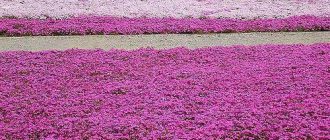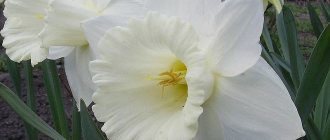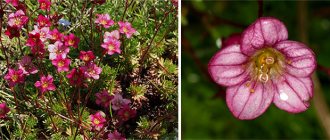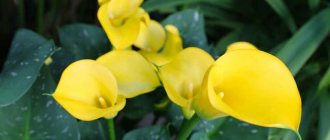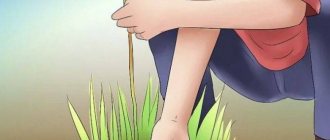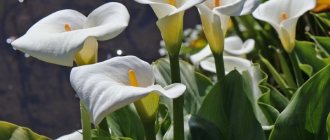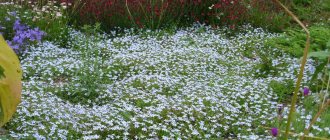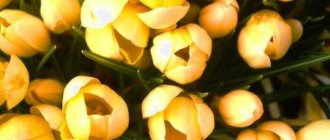The genus of semi-shrub succulents - Delosperma - is represented by a wide variety of shapes and colors. Colorful borders, flower beds, and alpine slides are created with the help of these amazing cover plants.
For long-term and successful cultivation at home and in the garden, you need to know all the intricacies of care. But first you need to choose the right variety, depending on where the plant “pet” will live. Frost-resistant specimens are selected for open ground; heat-loving specimens are suitable for indoor keeping. Proper watering, light, soil and many other subtleties will help you admire the multi-colored plant “mat” throughout the spring-summer flowering season.
Popular types
Species diversity amounts to hundreds of representatives. These are mostly indoor plants. But there are also cold-resistant specimens. They can be found in street flower beds. It’s worth getting to know both of them:
Delosperma floribundum
Lush flowering from many inflorescences occurs in the summer. The flowers barely reach three centimeters in diameter. The color is interesting: pink or purple oblong petals frame a white core. This species blooms in the same year that it was planted. This allows you to grow the succulent as an annual.
profusely blooming
Delosperma "Stardust" (D. Stardust)
A variety for long-term outdoor cultivation. Overwinters covered. Tolerates frosts below -20°. Flowers with white centers and pink endings on long petals. There is also a purple color with a lilac tint.
star dust
Delosperma Cooper (D. Cooperi)
Well branched plant, no higher than 15 centimeters. The shoots extend to almost half a meter in width. It withstands low temperatures well (down to minus seventeen degrees). Glossy and silky flower petals surround a creamy yellow center. The diameter of the flowers is larger than the previous type, up to five centimeters.
Cooper
Delosperma Twisted (D. Сongestum)
Frost resistance allows you to tolerate twenty-degree negative temperatures. The stems and castings create a dense green cover. In turn, bright yellow flowers cover the entire surface of the plant. Flowering begins in May. In the fall season, the greens give way to burgundy.
Twisted
Delosperma Tradiscantoides (D. Tradescantioides)
Long shoots “crawl” along the ground. When landing on a hill, they hang down. In appearance it resembles Tradescantia itself. The leaves are light and green. The flowers are small, snow-white.
Tradiscanceid
Dyer's Delosperma (D. Dyeri)
Hybrid with flowers in peach tones. Popular as an indoor specimen. Winters well. Tolerates frosts of minus 29 degrees. Varietal variations differ in color palette.
Dyer
Delosperma Pearl (D. Jewel) includes several varieties:
- Jewel Of Desert Opal – purple;
- Desert Pearl Garnet (Jewel of D. Garnet) – pomegranate petals, white-pink core;
- Desert Pearl Ruby (Jewel of D. Ruby) - flowers are red and purple.
Also read: Peperomia - species that accumulate moisture
Pearl
Delosperma Cloudy (D. Nubigenum)
Literally creeping “green stuff”. Height up to ten centimeters. Evergreen species. Survives at 23 degrees below zero. Flowering is represented by small, juicy shades of orange and yellow.
Cloud
Delosperma Sutherlandii (D. Sutherlandii)
The leaves and trunks have soft pubescence. Large flowers of rich lilac tone. The core is light yellow. Good cold resistance (-23°). It is a low-growing species.
Sutherland
Delosperma Lehmannii (D. Lehmannii)
Representative of indoor varieties. Decorative leaf formations. The leaf shape is triangular pyramid. Associated with a children's puzzle. Light yellow flowers.
Leman
Care
It is necessary to place Delosperma in the place most warmed by the rays of the sun. Neither heat nor drought can harm it. Dense, fleshy leaves store enough moisture to overcome dry periods. It is common for a plant to get sick and die from excess water (flooding, dampness).
Watering
- Watering activities are carried out strictly in the morning;
- The regime is observed relative to the seasons;
- During the period of intensive growth and flowering, the soil is allowed to dry out slightly between moistenings.
When “walking,” household residents will need to be protected from rainfall in order to prevent excessive soil moisture. During the rest period, the indoor inhabitants are allowed to dry out the earthen clod halfway.
Lighting
A lover of light requires open sunny corners. For home use, south-west, south-east or south windows with sufficient direct rays are suitable. Those growing in a flower garden need sun throughout the day. Growing in the southern regions requires light shading in the afternoon. Individuals planted in constant shade will stretch out and refuse to bloom.
Temperature
- In summer, it can quite easily withstand heat of +40 degrees for some time. The optimal temperature is about +27 degrees;
- The winter period is characterized by a decrease in thermal comfort to +7 – 10 degrees. Small fluctuations are acceptable in both directions for a fairly short time interval.
Humidity
There are no special requirements. In extreme summer heat, it is recommended to spray the area around the green carpet.
The soil
Must be:
- Light loose consistency. Promotes free growth of the root system;
- With good drainage qualities (water does not stagnate, protecting the flower from various types of rot);
- Poorly saturated with nutrients;
- Low acidity. The permissible upper limit is 6.5 pH.
Homemade soil is mixed from the following components:
- The land is turf;
- Leaf humus;
- Perlite one part;
- Brick crumbs, ten percent is added to the entire mass;
- Charcoal in the same ratio as brick;
- The surface is covered with moss or stones to reduce evaporation and maintain soil moisture for a longer time.
Transfer
Houseplants should be replanted only as needed. The reason for this may be a cramped pot, diseases and pests, rotting of the root system. It is recommended to transplant in the spring, before the growth stage begins.
Also read: Photos and names of flowering succulents
Fertilizer
Additional fertilizing should be applied if you have not transplanted the plant into new soil for more than two years. A complex mineral fertilizer is used, diluted in water, in half the dosage specified in the instructions. Oversaturation has a bad effect on growth and flowering. The shoots become very elongated and fewer flowers are produced. The optimal application regime is from mid-spring to mid-summer, with an interval of three weeks.
Illumination
For planting in open ground, choose open and illuminated areas of the garden. Each plant should be exposed to full sun all day. For growing at home, preference is given to southern window sills. The plant loves direct sunlight. But it should also be taken into account that in southern latitudes, where the sun is more active, it is necessary to shade the bushes in the afternoon. If a dark or dark place is chosen for the delosperma, this will interfere with its further comfortable growth. The shoots and leaves of the plant will be weak and elongated, with a pale green color, and its flowering will stop.
Reproduction (planting)
You can obtain fresh specimens for garden and home maintenance by sowing seeds on seedlings and cuttings. Each method is good in its own way:
Seeds
In indoor conditions, you can start obtaining spring planting material for flower beds a little after the middle of winter. The seedlings have time to grow stronger and produce early flowering.
- Natural stratification of seeds is achieved by using peat soil with snow. To do this, you need to place the prepared soil in a container, scatter the seeds on top and cover them with a small layer of snow. Having melted, the snow moistens the soil, slightly settling the seeds;
- The container is covered with film and placed in a cool place for half a month;
- The next step is adding lighting;
- The sprouts that appear must be opened. The soil should be moistened little by little, depending on how dry it is;
- At the stage of four or six grown leaves, picking is done into individual vessels;
- After preliminary hardening, the seedlings can be placed in the flower garden, provided there are no night frosts.
Cuttings
- At any point where the plant touches the ground, young roots are formed. By carefully lifting the stem, you can see areas with root shoots. Cuttings can be separated from adult specimens throughout the entire vegetative growth. When kept indoors, this process is year-round;
- A section with roots is separated from the stem and placed in a separate container or in a flower bed. A cutting with roots and young leaves is able to grow independently. If no roots have formed, the shoot is cut into pieces, no more than 7 and a half centimeters. Dry for two hours (until a protective film appears on the cuts);
- Cuttings are planted one by one in a plastic container filled with sand or a ready-made mixture for cacti. The pots are placed in a well-lit place. Watering is carried out carefully, without overwatering the soil or getting on the seedling. After a few days, the young plant took root;
- You can grow roots by placing the cutting in a jar of water. When it appears, place the new individual in a vessel with earth. After two months, the plant is ready to be planted in the garden. The soil on the planting site should be nutritious, soft, and not retain water.
To achieve looseness and good drainage, peat or sand component is added. The planting scheme provides for a distance of about half a meter between the Turks under the sprouts. The reason for this is the rapid growth of the surface of the ground part and the rhizomes underneath it.
Features of wintering
In the house
In winter, indoor delosperma experiences a period of dormancy. At this time, it is placed in a cool place (10–12 degrees). Watering should be scanty and infrequent (approximately once every 30 days), but do not allow the soil mixture in the pot to dry out.
There is no need to feed the bushes in winter, otherwise they will not stop growing. However, the emerging shoots will be thin, weakened and elongated. If the flower is kept warm in winter, then it needs to be provided with a large amount of light so that it does not lose its spectacular appearance.
In the garden
In open soil, the bushes can withstand air temperatures dropping to minus 15–20 degrees. To prevent the bush from rotting due to excess moisture during the thaw, you will need a special shelter. There are several options:
- the area is covered with a layer of dry leaves and spruce branches;
- a wooden box turned upside down is placed above each bush;
- a frame is made onto which the film and insulation are stretched.
You can also dig up a bush in the fall, plant it in a pot and bring it into the house. Annual delosperms are grown in spring from cuttings taken from an overwintered bush.
Trimming
Pinching or trimming is carried out as necessary. Serves as a stimulating effect:
- For growth. Tall stems are subjected to the process. The very top is removed;
- For flowering. The occupied flowers are removed;
- Increased decorativeness. Cleaning of sluggish, dead and diseased leaves and shoots;
- Relief of stressful conditions during transplantation. Several leaves are cut off at the bottom using cuttings or seedlings.
Also read: Ceropegia - a climbing frame plant
Bloom
The flowering period of delosperma is very long. The first “swallows” open at the end of May. You can admire the bright colors of flowers until late autumn. Single flowers in large numbers create colorful blankets of various sizes (depending on the area occupied by vegetation). The appearance of an individual flower is voluminous, due to the middle spherical filling of small petals.
The frame is formed by long oblong petals, arranged in one dense row or in several layers. The color range is rich in palette. From snow-white to deep purple shades. There are varieties that differ in the transitions from one color to another within each blossoming bud.
One important feature of this succulent should be taken into account - it blooms only in sunny weather. The predominance of cloudy days can deprive you of the opportunity to see a colorful meadow for the entire season.
Description of delosperma
Delosperma is a perennial creeping herb or subshrub with a woody stem base. The ground part of representatives of this genus is not higher than 0.1-0.3 m, but it is spreading and branched and can grow in width up to 0.4-0.5 m. Creeping and flattened branches often take root at the nodes.
The root system is short and fibrous with small oblong tubers or thickened fleshy rhizomes that serve to supply and store moisture. Due to this, the plant is able to withstand long dry periods.
Most varieties of this crop have narrow, lanceolate, slightly curved leaves up to 4 mm thick, which are often mistaken for stems. The color of the ground part can vary from bluish-gray to dark green. The surface of the leaf blades in some species is shiny and smooth, while in others it is covered with short villi. Through the stomata on the leaves, small crystals of calcium salts are released, which sparkle in the sunlight and look a little like frozen pieces of ice.
Delosperma flowers reach 70 mm in diameter and consist of a large number of thin, narrow, elongated petals arranged in one row or in several layers. In the center, smaller and thinner petals are formed in the shape of a ball, which makes the flower three-dimensional.
The color can be very different: pink, purple, white, yellow, salmon, lilac, violet, etc. Delosperma blooms from May to October. In cloudy and rainy weather, as well as at night, the petals close. With the first rays of the sun they open up again.
Diseases and pests
Delosperma is rarely susceptible to diseases and attacks by harmful insects. With proper care, you can avoid the appearance of various rots that can arise as a result of abundant and frequent watering, poor drainage function of the soil (stagnation of water).
Frequently observed pests include:
- Mealybugs. To treat plants, an insecticidal preparation with the active ingredient cypermethrin is used;
- Aphid. For mild lesions, a solution based on laundry soap has proven itself to be effective. Diluted in hot water at the rate of 15-17 grams per liter (a piece of soap per ten liters of water). When cooled, it is used to spray the shoots;
- Spider mite. It is necessary to collect as much as possible the representatives and their metabolic products with a soaked cotton swab from all accessible parts of the plant. The next step is to treat the entire flower with an acaricidal biological or chemical agent.
